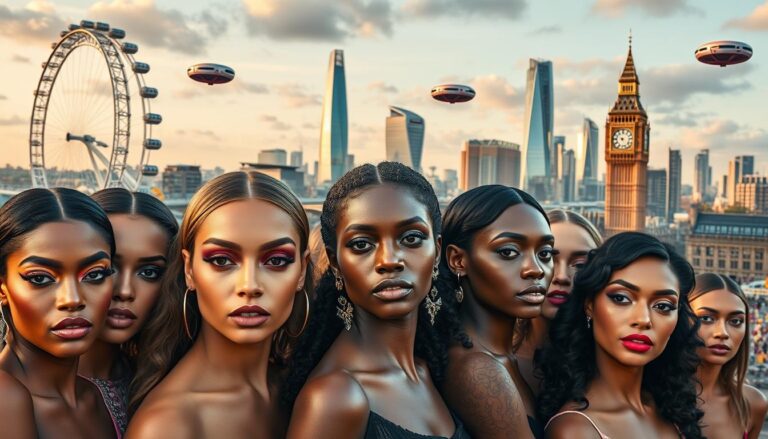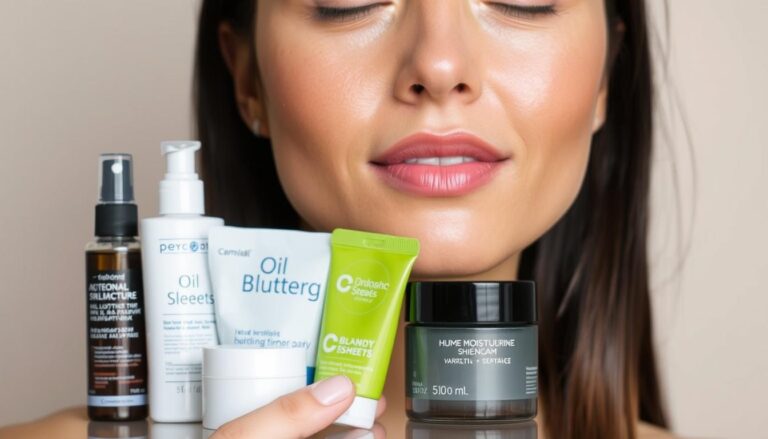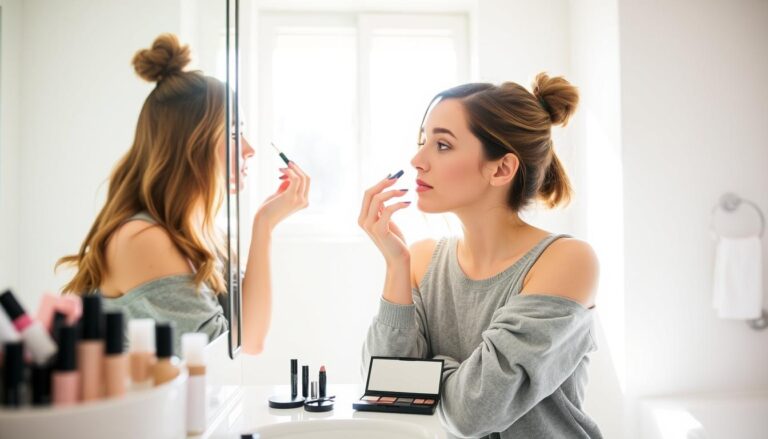At Glowskinhub.com, we believe beauty isn’t just a look—it’s a feeling
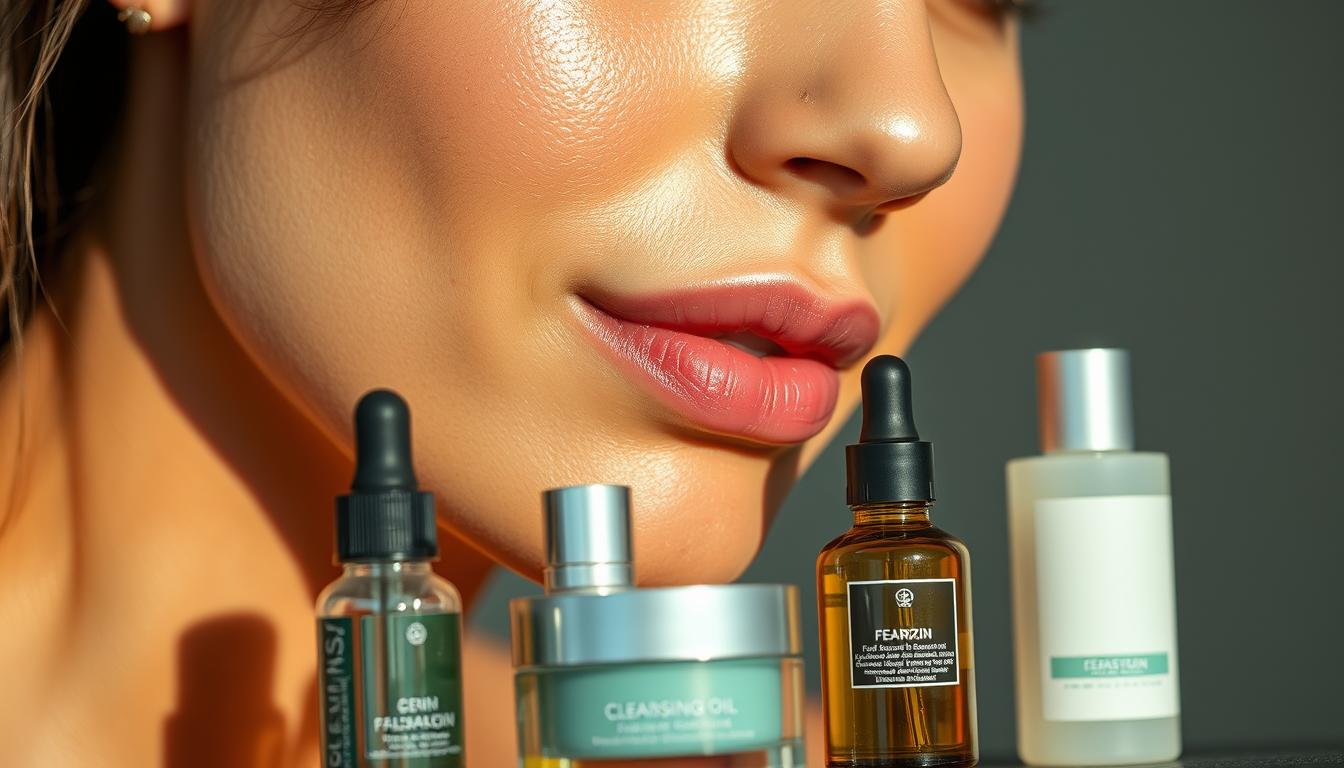
5 common makeup mistakes and how to fix them
Achieving a flawless, radiant complexion can be a daunting task, especially for those with oily Skin. Simple Skin care tips can make a significant difference, but makeup mistakes can still occur.
Many individuals struggle with enhancing their features without accentuating their flaws. By understanding the most prevalent errors and learning how to rectify them, you can ensure a polished finish that lasts.
With a few straightforward adjustments to your routine, you can overcome these issues and enjoy a more even, luminous appearance.
Key Takeaways
- Understand your Skin type to avoid exacerbating its characteristics.
- Choose products suitable for your Skin, such as oil-control foundations.
- Apply makeup techniques that enhance your features.
- Blending is crucial for a seamless finish.
- Setting your makeup can significantly extend its wear.
The Impact of Makeup Mistakes on Your Overall Look
Even small makeup errors can have a substantial effect on how we look and feel about ourselves. Makeup, when applied correctly, can enhance our features and boost our confidence. However, mistakes in application or product choice can lead to an undesirable outcome.
How Small Errors Can Dramatically Change Your Appearance
Small makeup mistakes, such as choosing the wrong foundation shade or improperly blending eyeshadow, can significantly alter our appearance. For instance, a foundation that doesn’t match our Skin tone can make our face appear uneven, while poorly blended eyeshadow can give our eyes an unnatural look.
Common makeup mistakes include:
- Using too much or too little makeup
- Not blending makeup properly
- Choosing the wrong shades for one’s Skin tone
Building Confidence Through Proper Technique
Mastering proper makeup techniques can greatly enhance our confidence. By understanding how to correctly apply makeup and choosing products suitable for our Skin type, e.g., following a proper oily Skin routine or best skincare routine for oily Skin, we can achieve a natural, polished look. This not only improves our appearance but also makes us feel more self-assured.
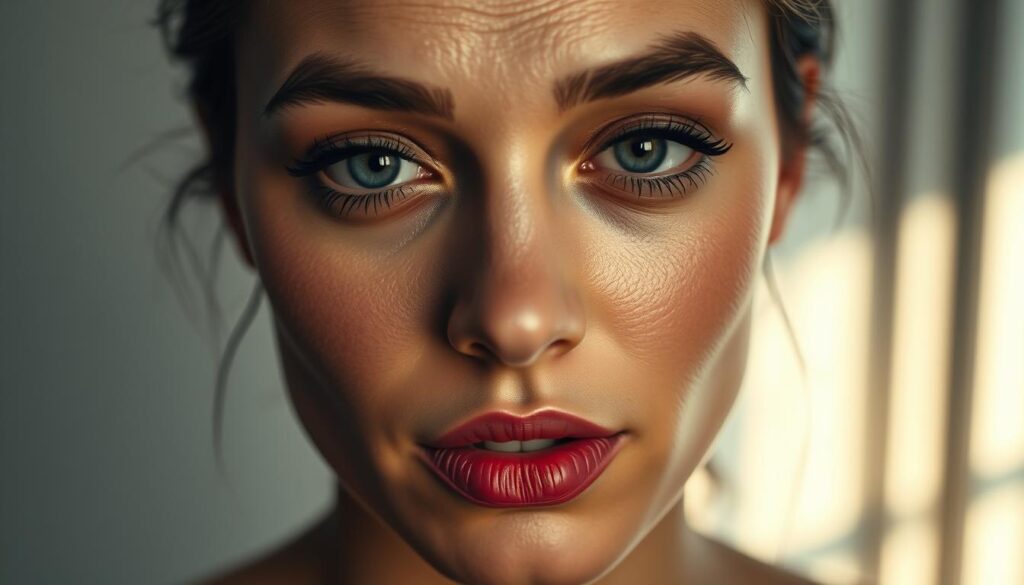
By being aware of common makeup mistakes and learning how to avoid them, we can ensure a flawless, confidence-boosting makeup application.
Creating the Perfect Canvas: Skincare Before Makeup
A well-prepared Skin canvas is crucial for a flawless makeup application. Proper skincare before makeup not only enhances the appearance but also ensures longevity of the makeup look.
Essential Prep Steps for Flawless Application
To achieve a smooth canvas, start by cleansing your Skin thoroughly. Use a gentle cleanser suitable for your Skin type. Next, exfoliate once or twice a week to remove dead Skin cells and unclog pores. Follow up with a toner to balance your Skin’s pH and prepare it for subsequent products.
Moisturising is also crucial, even for oily Skin. Use a lightweight, oil-free moisturiser to hydrate your Skin without clogging pores. Finally, apply a primer to create an even surface for makeup.
Addressing Oily Skin Concerns Before Makeup
Oily Skin can be challenging, but there are specific steps you can take. Use oil-controlling products that are labelled “non-comedogenic” or “oil-free” to help manage shine. Consider using a clay-based mask once a week to absorb excess oil.
Balancing Products for Combination Skin
For combination Skin, it’s about finding a balance. Use a gentle, non-comedogenic cleanser and a lightweight moisturiser on oily areas, while providing extra hydration to dry areas. Be cautious with product application to avoid exacerbating oiliness or dryness.
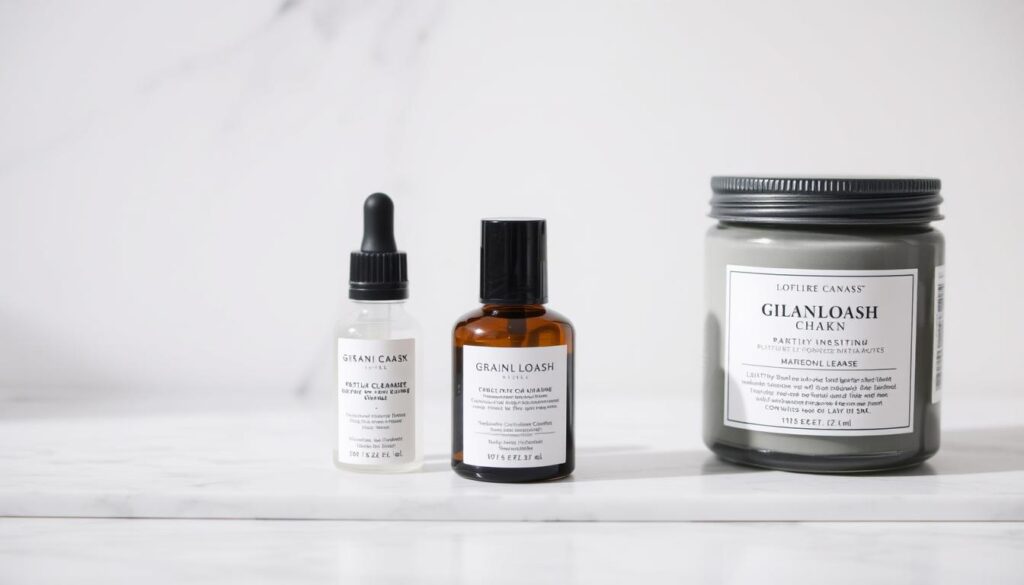
Mistake1: Choosing the Wrong Foundation Shade
One of the most common makeup mistakes is choosing a foundation shade that doesn’t match your Skin tone. This can lead to a visible demarcation line along the jawline, making the makeup look unnatural and poorly applied.
Telltale Signs Your Foundation Doesn’t Match
If your foundation doesn’t match your Skin tone, there are several signs to look out for. These include a visible foundation line along the jawline or hairline, a colour that’s too pink or too yellow for your Skin, and a finish that either looks too matte or too shiny for your Skin type. For those with oily Skin, it’s essential to choose a foundation that controls shine without drying out the Skin.
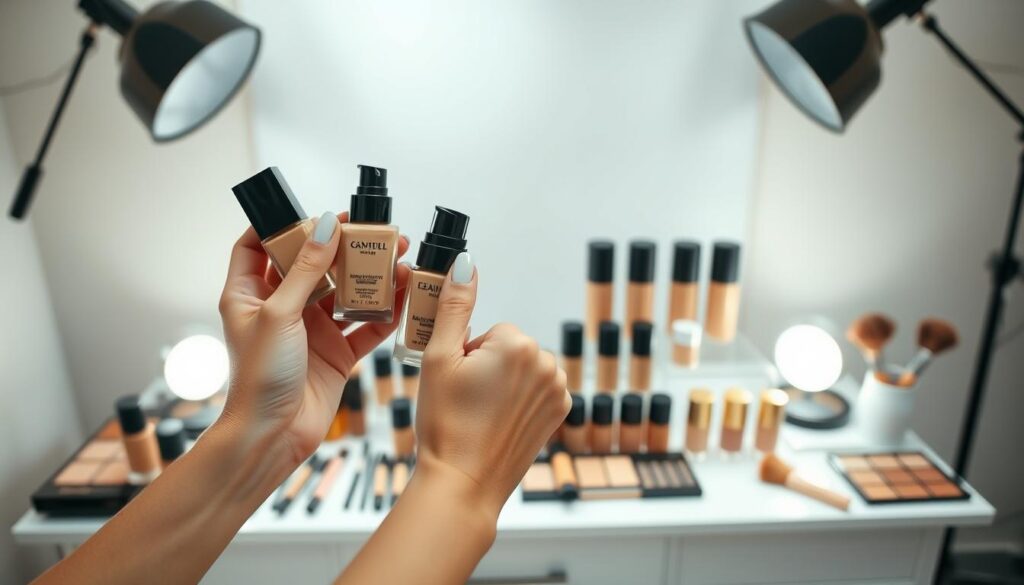
Finding Your Perfect Shade: Testing Techniques
To find your perfect foundation shade, test the product on your jawline. This area is ideal because it helps you see how the foundation will look on both your face and neck. For individuals with oily Skin, it’s advisable to use the “best products for oily Skin” that are labelled “oil-free” or “non-comedogenic.”
| Skin Type | Ideal Foundation Type | Key Features to Look For |
|---|---|---|
| Oily Skin | Matte or Oil-Control Foundation | Oil-free, non-comedogenic, salicylic acid |
| Dry Skin | Hydrating or Moisturizing Foundation | Hydrating ingredients, SPF |
| Combination Skin | Balancing Foundation | Lightweight, buildable coverage |
Seasonal Adjustments for Your Foundation
Your Skin tone can change with the seasons due to variations in sun exposure. It’s crucial to adjust your foundation shade accordingly. In the summer, you may need a darker shade, while in the winter, a lighter shade might be more suitable.
Colour Matching in Different Lighting
When testing foundation shades, check the colour match in different lighting conditions. Natural daylight is ideal, but if that’s not possible, use a light that mimics natural daylight. This ensures that your foundation looks good in various environments.
Mistake2: Improper Blending Techniques
Achieving a seamless makeup look hinges on proper blending techniques, a step often overlooked. When blending is done correctly, it creates a natural finish that enhances one’s features without looking cakey or obvious.
Identifying Harsh Lines and Patchiness
One of the first signs of improper blending is the appearance of harsh lines or patchiness on the Skin. This can be particularly noticeable around the hairline, jawline, and edges of the face. To avoid this, it’s essential to use the right tools and techniques.
Tools That Transform Your Blending Game
Using the right tools can make a significant difference in blending. Beauty blenders and fluffy brushes are excellent for creating a smooth finish. For instance, a Beauty blender is ideal for blending foundation and concealer, while a fluffy brush works well for powder products.

The Circular Motion Method for Seamless Results
One effective technique for blending is the circular motion method. This involves gently moving your blending tool in circular motions to merge the makeup with the Skin. It’s particularly effective for liquid and cream products.
Blending Different Product Formulations
Different products require different blending techniques. For example, liquid foundations blend well with a Beauty blender, while powder products are better suited to a fluffy brush. Understanding the formulation of your product and choosing the right tool is key to achieving a seamless finish.
For individuals with oily Skin, using an oily Skin moisturizer before makeup can help create a smoother canvas for blending. This step is crucial in achieving a flawless look that lasts throughout the day.
- Use the right tools for the job, such as Beauty blenders or fluffy brushes.
- Blend in circular motions for a seamless finish.
- Choose the appropriate blending technique based on your product formulation.
Mistake3: Overdoing Eyebrow Makeup
The ‘Instagram brow’ phenomenon has made it tempting to overfill and overdefine eyebrows, but this can lead to a harsh, unnatural look. Overdoing eyebrow makeup is a common mistake that can significantly impact your overall appearance.
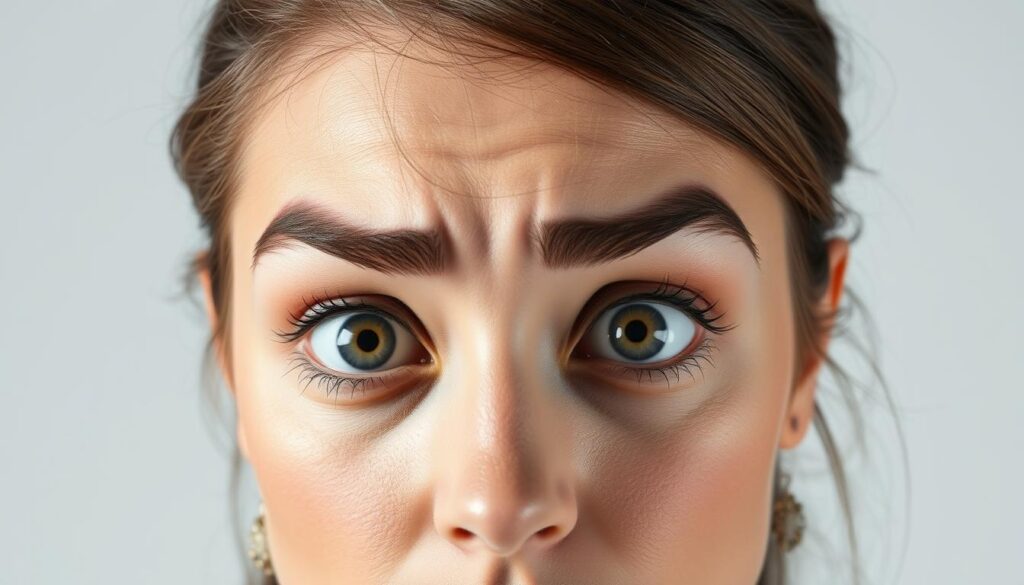
The “Instagram Brow” Pitfall
The trend of having perfectly groomed and filled eyebrows can be challenging to achieve without looking unnatural. The key is to find a balance between definition and natural appearance.
Techniques for Natural-Looking Definition
To achieve naturally defined eyebrows, use light strokes with your brow pencil or brush. Less is more when it comes to filling in sparse areas. It’s also crucial to choose a product that matches your natural brow color.
Correcting Common Brow Mishaps
If you’ve overdone your eyebrows, there are ways to correct the look. Using a concealer one shade lighter than your foundation can help clean up the edges and create a more defined shape.
Product Selection Based on Your Brow Type
Different brow types require different products. Here’s a comparison of products suitable for various brow types:
| Brow Type | Recommended Product | Key Benefit |
|---|---|---|
| Sparse Brows | Brow Gel | Helps keep brow hairs in place |
| Thick Brows | Brow Pomade | Allows for precise definition |
| Unruly Brows | Brow Wax | Provides strong hold |
By choosing the right product and technique, you can enhance your eyebrows without overdoing it. For those with oily Skin, considering an oily Skin treatment before makeup can also help your brow makeup stay in place longer.
Mistake4: Incorrect Concealer Application
Achieving a seamless finish with concealer is a skill that requires understanding the right techniques. Concealer is a powerful tool in makeup, capable of transforming your look by hiding blemishes, dark circles, and other imperfections.
Under-Eye Triangle vs. Spot Concealing
The method of applying concealer under the eyes in a triangular shape is popular for brightening the area. However, spot concealing directly on blemishes can be more effective for targeted coverage. Choosing the right method depends on your specific Skin concerns. For instance, if dark circles are your main issue, the under-eye triangle method can be highly effective.
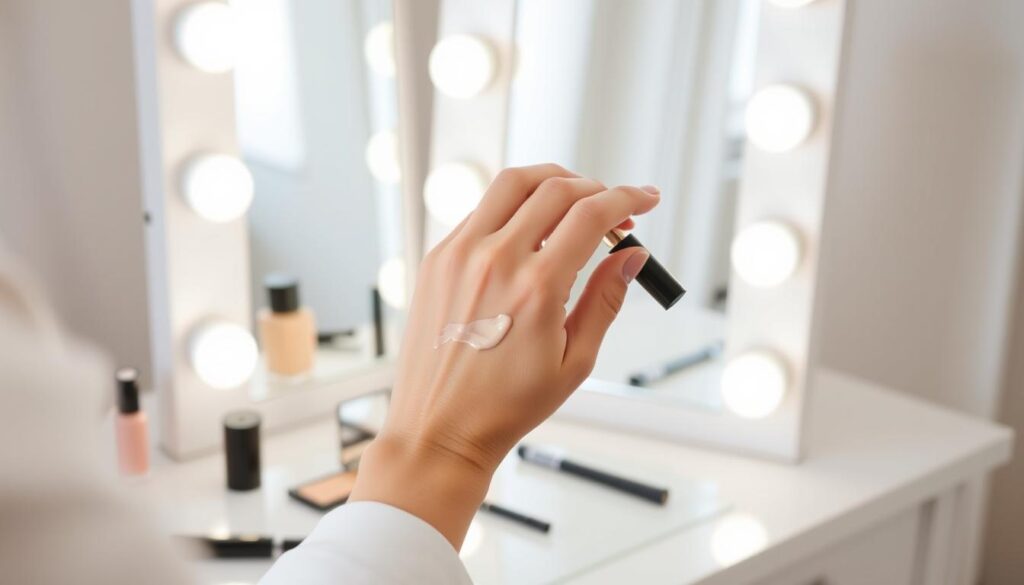
Colour Correction for Different Skin Concerns
Colour correction is a crucial step in concealer application. Different Skin concerns require different colour correctors. For example, green correctors counteract redness, while yellow or peach correctors are used to brighten dark circles. Understanding the colour wheel is key to effective colour correction.
| Skin Concern | Colour Corrector |
|---|---|
| Redness | Green |
| Dark Circles | Yellow or Peach |
Setting Techniques That Prevent Creasing
To prevent concealer from creasing, especially under the eyes, setting it with a powder is essential. Translucent powder is a versatile option that works for most Skin types. A light dusting is all that’s needed to keep your concealer in place all day.
Layering Products for Maximum Coverage
Layering concealer and other products can enhance coverage. Start with a thin layer of concealer, followed by a light dusting of powder, and repeat as necessary. This technique helps achieve maximum coverage without looking cakey. Maintaining a best skincare routine for oily Skin can also help your makeup stay in place longer.
“The key to flawless makeup is not just the products you use, but how you use them.”
By mastering concealer application techniques and understanding how to layer products effectively, you can achieve a flawless, natural-looking finish that enhances your features.
Mistake5: Poor Lipstick Application
Poor lipstick application is a common makeup mistake that can detract from your overall appearance. A well-applied lipstick can enhance your features, while a poorly applied one can make your lips look uneven or unappealing.
Preventing Feathering and Bleeding
Feathering and bleeding occur when lipstick migrates beyond the lip lines, creating an untidy appearance. To prevent this, use a lip liner that matches your natural lip colour or the shade of your lipstick. Applying a lip primer can also help in creating a barrier that keeps your lipstick in place.

Lip Prep Routines for Smooth Application
Prepping your lips is essential for a smooth lipstick application. Start by exfoliating your lips gently with a lip scrub to remove dead Skin cells. Follow this with a lip balm to moisturize, especially if you have dry lips. For those with oily Skin, incorporating an oily Skin routine that includes gentle lip care can help maintain lip health without exacerbating oiliness.
Techniques for Dimensional Lip Colour
Achieving dimensional lip colour involves more than just applying one shade. You can create depth by using different shades on different parts of your lips. For instance, apply a lighter shade in the centre of your lips and a slightly darker shade on the outer edges.
Fixing Lipstick Mistakes Without Starting Over
If you’ve made a mistake with your lipstick application, there’s no need to start over. You can correct it by gently blotting the area with a tissue and then reapplying lipstick or concealer around the edges to clean up any mistakes.
| Common Lipstick Mistakes | Quick Fixes |
|---|---|
| Feathering or bleeding | Use a lip liner and apply lipstick carefully |
| Uneven application | Blot with a tissue and reapply |
| Dry, patchy lips | Exfoliate and moisturize before applying lipstick |
Essential Makeup Tools: Choosing and Using Correctly
The secret to a professional-looking makeup application lies not just in the products used, but also in the tools that apply them. Just as a painter relies on their brushes to create a masterpiece, a makeup artist depends on their tools to achieve a flawless finish.
Brush Types and Their Specific Purposes
Different makeup brushes are designed for specific tasks. For instance, a flat foundation brush is ideal for applying liquid foundation, providing a smooth, even base. On the other hand, a fluffy powder brush is perfect for dusting off excess powder, ensuring a natural finish. Understanding the purpose of each brush can significantly enhance your makeup application.
| Brush Type | Primary Use |
|---|---|
| Flat Foundation Brush | Applying liquid foundation |
| Fluffy Powder Brush | Dusting off excess powder |
| Angled Eyeliner Brush | Creating precise eyeliner |
Sponge Techniques for Different Finishes
Makeup sponges are versatile tools that can be used to achieve various finishes. Dampening a sponge can help in achieving a more natural, dewy look, while using it dry can result in a fuller coverage. For individuals with oily Skin, using a damp sponge can also help in minimizing the appearance of pores, a technique that complements skincare for oily Skin routines.
“A good makeup sponge can be a game-changer in your Beauty routine, allowing for a seamless application of foundation and other products.”
Cleaning and Maintaining Your Tools
Regular cleaning of makeup tools is crucial for hygiene and effectiveness. Brushes should be washed with mild soap and lukewarm water, while sponges should be cleaned with a gentle cleanser. Proper maintenance not only extends the life of your tools but also ensures that your makeup applies smoothly and evenly.
Adapting Your Makeup for Different Occasions
Mastering the art of adapting your makeup for different occasions can elevate your overall appearance. Whether you’re preparing for a casual daytime event or a formal evening affair, your makeup should be adjusted accordingly.
Daytime Makeup That Withstands the Elements
For daytime, focus on creating a natural look that withstands various elements such as humidity or wind.
- Use a lightweight foundation that matches your Skin tone.
- Apply a subtle blush to give your cheeks a healthy glow.
- For oily Skin, consider using oily Skin products like oil-free foundation and powder to keep shine at bay.
Evening Looks That Photograph Well
Evening makeup should be more dramatic to photograph well.
- Enhance your eyes with eyeshadow and eyeliner.
- Define your lips with a lip liner and lipstick.
- Ensure your makeup is well-blended to avoid harsh lines in photos.
Special Event Considerations
For special events, consider the theme and dress code.
- For a wedding, opt for a timeless, elegant look.
- For a festival, you can be more creative with your makeup.
- Always choose best products for oily Skin if you have oily Skin to prevent excessive shine.
By adapting your makeup for different occasions, you can ensure you always look your best.
5 Common Makeup Mistakes and How to Fix Them: Professional Solutions
For those struggling with common makeup mistakes, professional solutions can make all the difference in achieving a polished look. Makeup artists often have tricks up their sleeves to correct issues that can ruin an otherwise perfect face.
Makeup Artists’ Emergency Correction Techniques
One common issue is overdone foundation. Makeup artists recommend starting with a light hand and building coverage gradually. Another technique is using a damp sponge to blend out harsh lines, creating a seamless finish.
Product Recommendations for Foolproof Application
For individuals with oily Skin, a mattifying primer can be a game-changer. Using an oily Skin moisturizer before applying makeup can also help control shine. A well-chosen foundation that matches your Skin tone is crucial.
| Product | Purpose | Benefit |
|---|---|---|
| Mattifying Primer | Minimize pores and control shine | Long-lasting makeup |
| Oily Skin Moisturizer | Hydrate without clogging pores | Balanced Skin |
| Foundation | Even out Skin tone | Flawless base |
Customising Fixes for Your Skin Type
Understanding your Skin type is key to customising your oily Skin regimen. For oily Skin, focus on oil-control products. For dry Skin, ensure you’re using a hydrating moisturizer before makeup.
By incorporating these professional tips and products into your routine, you can achieve a flawless, long-lasting makeup look that enhances your natural Beauty.
Conclusion
By understanding and addressing common makeup mistakes, individuals can significantly enhance their overall appearance. Proper skincare, including oily Skin treatment, lays the foundation for a smooth makeup application. Techniques such as correct blending, subtle eyebrow definition, and precise concealer application can make a substantial difference. Choosing the right products and tools is also crucial. By incorporating these simple fixes into daily routines, users can achieve a more polished, professional look that boosts confidence.
Mastering makeup is about practice and patience. With the right techniques and products, anyone can improve their makeup skills. Start by identifying your common mistakes and applying the fixes discussed. For those with oily Skin, incorporating an effective oily Skin treatment into your skincare routine can greatly improve makeup adherence and longevity.

